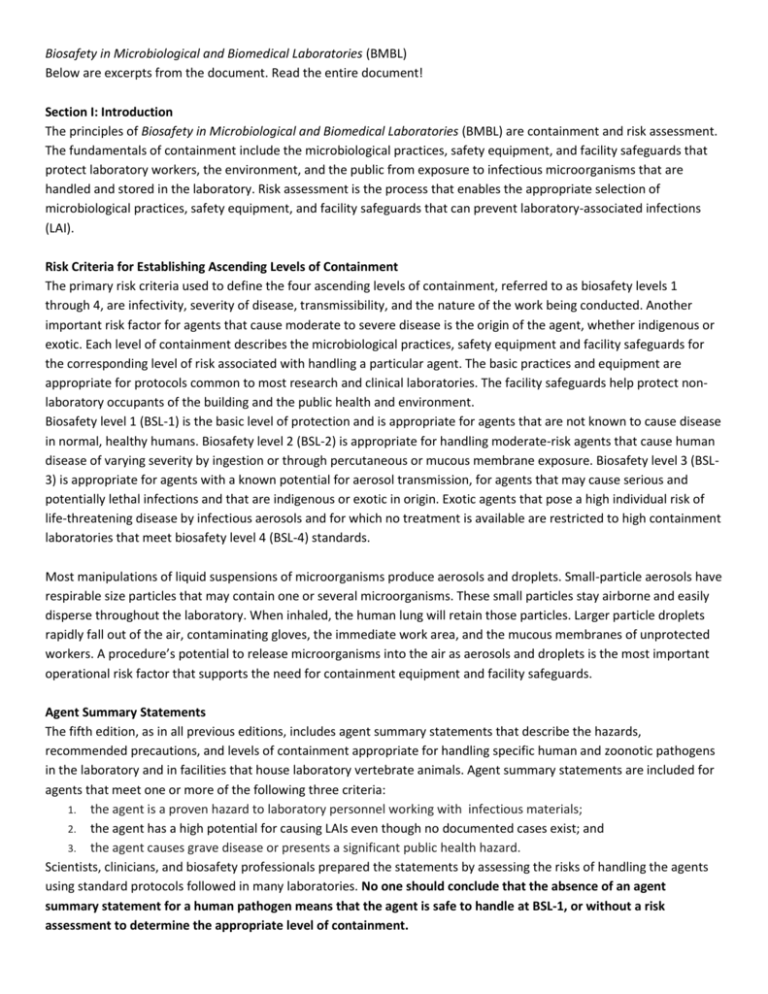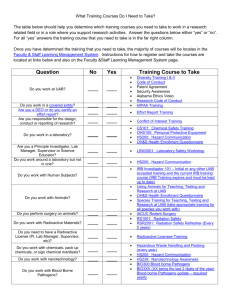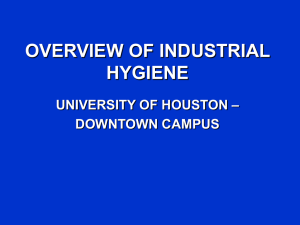Biosafety in Microbiological and Biomedical Laboratories (BMBL
advertisement

Biosafety in Microbiological and Biomedical Laboratories (BMBL) Below are excerpts from the document. Read the entire document! Section I: Introduction The principles of Biosafety in Microbiological and Biomedical Laboratories (BMBL) are containment and risk assessment. The fundamentals of containment include the microbiological practices, safety equipment, and facility safeguards that protect laboratory workers, the environment, and the public from exposure to infectious microorganisms that are handled and stored in the laboratory. Risk assessment is the process that enables the appropriate selection of microbiological practices, safety equipment, and facility safeguards that can prevent laboratory-associated infections (LAI). Risk Criteria for Establishing Ascending Levels of Containment The primary risk criteria used to define the four ascending levels of containment, referred to as biosafety levels 1 through 4, are infectivity, severity of disease, transmissibility, and the nature of the work being conducted. Another important risk factor for agents that cause moderate to severe disease is the origin of the agent, whether indigenous or exotic. Each level of containment describes the microbiological practices, safety equipment and facility safeguards for the corresponding level of risk associated with handling a particular agent. The basic practices and equipment are appropriate for protocols common to most research and clinical laboratories. The facility safeguards help protect nonlaboratory occupants of the building and the public health and environment. Biosafety level 1 (BSL-1) is the basic level of protection and is appropriate for agents that are not known to cause disease in normal, healthy humans. Biosafety level 2 (BSL-2) is appropriate for handling moderate-risk agents that cause human disease of varying severity by ingestion or through percutaneous or mucous membrane exposure. Biosafety level 3 (BSL3) is appropriate for agents with a known potential for aerosol transmission, for agents that may cause serious and potentially lethal infections and that are indigenous or exotic in origin. Exotic agents that pose a high individual risk of life-threatening disease by infectious aerosols and for which no treatment is available are restricted to high containment laboratories that meet biosafety level 4 (BSL-4) standards. Most manipulations of liquid suspensions of microorganisms produce aerosols and droplets. Small-particle aerosols have respirable size particles that may contain one or several microorganisms. These small particles stay airborne and easily disperse throughout the laboratory. When inhaled, the human lung will retain those particles. Larger particle droplets rapidly fall out of the air, contaminating gloves, the immediate work area, and the mucous membranes of unprotected workers. A procedure’s potential to release microorganisms into the air as aerosols and droplets is the most important operational risk factor that supports the need for containment equipment and facility safeguards. Agent Summary Statements The fifth edition, as in all previous editions, includes agent summary statements that describe the hazards, recommended precautions, and levels of containment appropriate for handling specific human and zoonotic pathogens in the laboratory and in facilities that house laboratory vertebrate animals. Agent summary statements are included for agents that meet one or more of the following three criteria: 1. the agent is a proven hazard to laboratory personnel working with infectious materials; 2. the agent has a high potential for causing LAIs even though no documented cases exist; and 3. the agent causes grave disease or presents a significant public health hazard. Scientists, clinicians, and biosafety professionals prepared the statements by assessing the risks of handling the agents using standard protocols followed in many laboratories. No one should conclude that the absence of an agent summary statement for a human pathogen means that the agent is safe to handle at BSL-1, or without a risk assessment to determine the appropriate level of containment. Section II—Biological Risk Assessment Risk assessment is an important responsibility for directors and principal investigators of microbiological and biomedical laboratories. Institutional biosafety committees (IBC), animal care and use committees, biological safety professionals, and laboratory animal veterinarians share in this responsibility. Risk assessment is a process used to identify the hazardous characteristics of a known infectious or potentially infectious agent or material, the activities that can result in a person’s exposure to an agent, the likelihood that such exposure will cause a LAI, and the probable consequences of such an infection. The information identified by risk assessment will provide a guide for the selection of appropriate biosafety levels and microbiological practices, safety equipment, and facility safeguards that can prevent LAIs. The primary factors to consider in risk assessment and selection of precautions fall into two broad categories: agent hazards and laboratory procedure hazards. In addition, the capability of the laboratory staff to control hazards must be considered. This capability will depend on the training, technical proficiency, and good habits of all members of the laboratory, and the operational integrity of containment equipment and facility safeguards. Hazardous Characteristics of an Agent The principal hazardous characteristics of an agent are: its capability to infect and cause disease in a susceptible human or animal host, its virulence as measured by the severity of disease, and the availability of preventive measures and effective treatments for the disease. Table 1: Classification of Infectious Microorganisms by Risk Group Risk Group NIH Guidelines for Research World Health Organization Laboratory Classification involving Recombinant DNA Biosafety Manual 3rd Edition 20041 Molecules 20022 Risk Group 1 Agents not associated with disease in healthy adult humans. (No or low individual and community risk) A microorganism unlikely to cause human or animal disease. Risk Group 2 Agents associated with human disease that is rarely serious and for which preventive or therapeutic interventions are often available. (Moderate individual risk; low community risk) A pathogen that can cause human or animal disease but is unlikely to be a serious hazard to laboratory workers, the community, livestock or the environment. Laboratory exposures may cause serious infection, but effective treatment and preventive measures are available and therisk of spread of infection is limited. Risk Group 3 Agents associated with serious or lethal human disease for which preventive or therapeutic interventions may be available (high individual risk but low community risk). (High individual risk; low community risk) A pathogen that usually causes serious human or animal disease but does not ordinarily spread from one infected individual to another. Effective treatment and preventive measures are available. Risk Group 4 Agents likely to cause serious or lethal human disease for which preventive or therapeutic interventions are not usually available (high individual risk and high community risk). (High individual and community risk) A pathogen that usually causes serious human or animal disease and can be readily transmitted from one individual to another, directly or indirectly. Effective treatment and preventive measures are not usually available. The predominant probable routes of transmission in the laboratory are: 1) direct skin, eye or mucosal membrane exposure to an agent; 2) parenteral inoculation by a syringe needle or other contaminated sharp, or by bites from infected animals and arthropod vectors; 3) ingestion of liquid suspension of an infectious agent, or by contaminated hand to mouth exposure; and 4) inhalation of infectious aerosols. The American Public Health Association publication Control of Communicable Diseases Manual is an excellent reference for identifying both natural and often noted laboratory modes of transmission.3 However, it is important to remember that the nature and severity of disease caused by a laboratory infection and the probable laboratory route of transmission of the infectious agent may differ from the route of transmission and severity associated with the naturally-acquired disease. An agent capable of transmitting disease through respiratory exposure to infectious aerosols is a serious laboratory hazard, both for the person handling the agent and for other laboratory occupants. This hazard requires special caution because infectious aerosols may not be a recognized route of transmission for the natural disease. Infective dose and agent stability are particularly important in establishing the risk of airborne transmission of disease. Working with animals: Experiments that demonstrate transmission of disease from an infected animal to a normal animal housed in the same cage are reliable indicators of hazard. Experiments that do not demonstrate transmission, however, do not rule out hazard. For example, experimental animals infected with Francisella tularensis, Coxiella burnetii, Coccidioides immitis, or Chlamydia psittaci—agents that have caused many LAIs—rarely infect cagemates.8 The origin of the agent is also important in risk assessment. Non-indigenous agents are of special concern because of their potential to introduce risk of transmission, or spread of human and animal or infectious diseases from foreign countries into the United States. Genetically modified agent hazards. The identification and assessment of hazardous characteristics of genetically modified agents involve consideration of the same factors used in risk assessment of the wild-type organism. It is particularly important to address the possibility that the genetic modification could increase an agent’s pathogenicity or affect its susceptibility to antibiotics or other effective treatments. The risk assessment can be difficult or incomplete, because important information may not be available for a newly engineered agent. Risk assessment is a continuing process that requires updating as research progresses. The NIH Guidelines are the key reference in assessing risk and establishing an appropriate biosafety level for work involving recombinant DNA molecules. Recombinant DNA research subject to the NIH Guidelines may require: 1) approval by the NIH Director, review by the NIH Recombinant DNA Advisory Committee (RAC), and approval by the IBC; or 2) review by the NIH Office of Biotechnology Activities (OBA) and approval by the IBC; or 3) review by the RAC and approvals by the IBC and Institutional Review Board; or 4) approval by the IBC prior to initiation of the research; or 5) notification of the IBC simultaneous with initiation of the work. It is important to note that review by an IBC is required for all non-exempt experiments as defined by the NIH Guidelines. Cell cultures. Workers who handle or manipulate human or animal cells and tissues are at risk for possible exposure to potentially infectious latent and adventitious agents that may be present in those cells and tissues. This risk is well understood and illustrated by the reactivation of herpes viruses from latency, the inadvertent transmission of disease to organ recipients, and the persistence of human immunodeficiency virus (HIV), HBV, and hepatitis C virus (HCV) within infected individuals in the U.S. population. There also is evidence of accidental transplantation of human tumor cells to healthy recipients which indicates that these cells are potentially hazardous to laboratory workers who handle them. The potential for human cell lines to harbor a bloodborne pathogen led the Occupational Health and Safety Administration (OSHA) to interpret that the occupational exposure to bloodborne pathogens final rule would include primary human cell lines and explants. Hazardous Characteristics of Laboratory Procedures Investigations of LAIs have identified five principal routes of laboratory transmission. These are parenteral inoculations with syringe needles or other contaminated sharps, spills and splashes onto skin and mucous membranes, ingestion through mouth pipetting, animal bites and scratches, and inhalation exposures to infectious aerosols. The first four routes of laboratory transmission are easy to detect, but account for less than 20 percent of all reported LAIs. Aerosols are a serious hazard because they are ubiquitous in laboratory procedures, are usually undetected, and are extremely pervasive, placing the laboratory worker carrying out the procedure and other persons in the laboratory at risk of infection. Procedures that impart energy to a microbial suspension will produce aerosols. Procedures and equipment used routinely for handling infectious agents in laboratories, such as pipetting, blenders, non-self contained centrifuges, sonicators and vortex mixers are proven sources of aerosols. These procedures and equipment generate respirable-size particles that remain airborne for protracted periods. When inhaled, these particles are retained in the lungs creating an exposure hazard for the person performing the operation, coworkers in the laboratory, and a potential hazard for persons occupying adjacent spaces open to air flow from the laboratory. Procedures and equipment that generate respirable size particles also generate larger size droplets that can contain multiple copies of an infectious agent. The larger size droplets settle out of the air rapidly, contaminating the gloved hands and work surface and possibly the mucous membranes of the persons performing the procedure. An evaluation of the release of both respirable particles and droplets from laboratory operations determined that the respirable component is relatively small and does not vary widely; in contrast hand and surface contamination is substantial and varies widely. Technique can significantly impact aerosol output and dose. Containment and good laboratory practices also reduce this risk. Potential Hazards Associated with Work Practices, Safety Equipment and Facility Safeguards Workers are the first line of defense for protecting themselves, others in the laboratory, and the public from exposure to hazardous agents. Protection depends on the conscientious and proficient use of good microbiological practices and the correct use of safety equipment. Carelessness is the most serious concern. Training, experience, knowledge of the agent and procedure hazards, good habits, caution, attentiveness, and concern for the health of coworkers are prerequisites for a laboratory staff in order to reduce the inherent risks that attend work with hazardous agents. Laboratory directors or principal investigators should train and retrain new staff to the point where aseptic techniques and safety precautions become second nature. There may be hazards that require specialized personal protective equipment in addition to safety glasses, laboratory gowns, and gloves. For example, a procedure that presents a splash hazard may require the use of a mask and a face shield to provide adequate protection. Safety equipment such as biological safety cabinets (BSC), centrifuge safety cups, and sealed rotors are used to provide a high degree of protection for the laboratory worker from exposure to microbial aerosols and droplets. Facility safeguards help prevent the accidental release of an agent from the laboratory. Their use is particularly important at BSL-3 and BSL-4 because the agents assigned to those levels can transmit disease by the inhalation route or can cause life-threatening disease. An Approach to Assess Risks and Select Appropriate Safeguards A five-step approach that gives structure to the risk assessment process: First, identify agent hazards and perform an initial assessment of risk. Consider the principal hazardous characteristics of the agent, which include its capability to infect and cause disease in a susceptible human host, severity of disease, and the availability of preventive measures and effective treatments. The BMBL provides agent summary statements for some agents that are associated with LAIs or are of increased public concern. Agent summary statements also identify known and suspected routes of transmission of laboratory infection and, when available, information on infective dose, host range, agent stability in the environment, protective immunizations, and attenuated strains of the agent. The Control of Communicable Diseases Manual provides information on communicable diseases including concise summaries on severity, mode of transmission, and the susceptibility and resistance of humans to disease.3 In addition, it is always helpful to seek guidance from colleagues with experience in handling the agent and from biological safety professionals. Consult interim biosafety guidelines prepared by the CDC and the WHO for risk assessment guidance. Second, identify laboratory procedure hazards. The principal laboratory procedure hazards are agent concentration, suspension volume, equipment and procedures that generate small particle aerosols and larger airborne particles (droplets), and use of sharps. Procedures involving animals can present a number of hazards such as bites and scratches, exposure to zoonotic agents, and the handling of experimentally generated infectious aerosols. Third, make a determination of the appropriate biosafety level and select additional precautions indicated by the risk assessment. The selection of the appropriate biosafety level and the selection of any additional laboratory precautions require a comprehensive understanding of the practices, safety equipment, and facility safeguards described in Sections III, IV, and V of this publication. Fourth, evaluate the proficiencies of staff regarding safe practices and the integrity of safety equipment. The protection of laboratory workers, other persons associated with the laboratory, and the public will depend ultimately on the laboratory workers themselves. Fifth, review the risk assessment with a biosafety professional, subject matter expert, and the IBC.







